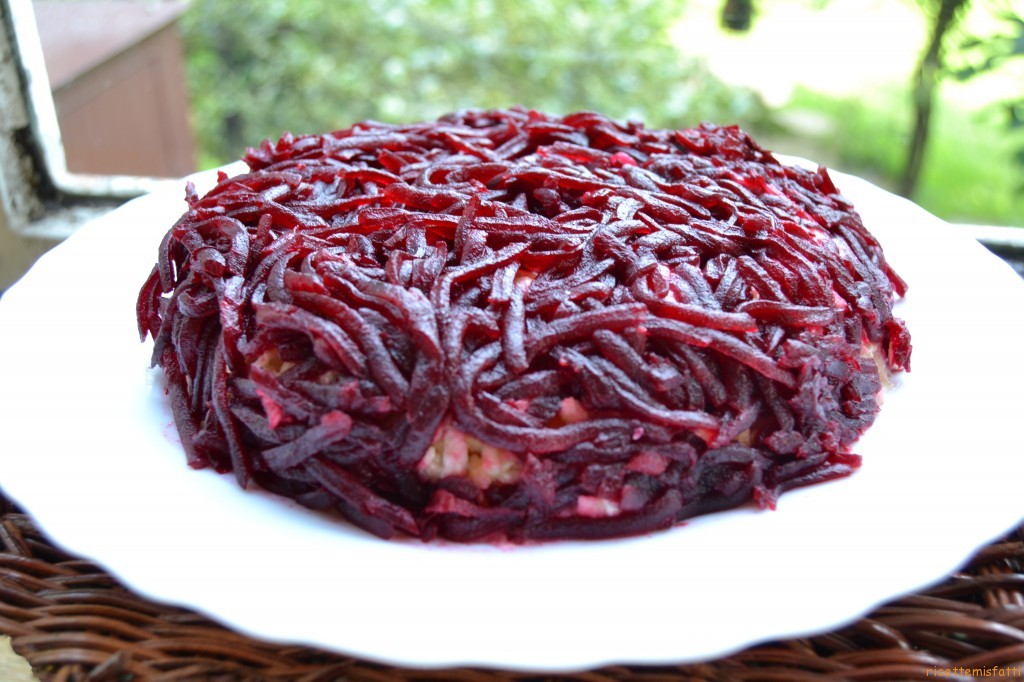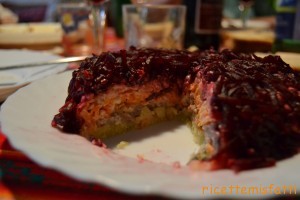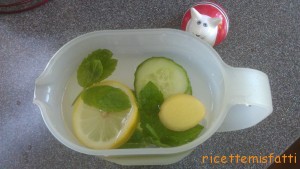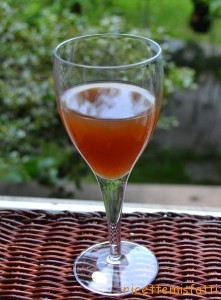I bet I’m not the only one who loves naan bread! I often order one to accompany a curry when I go to an Indian restaurant. It’s one of my favourite things. Despite my love for it, for some reasons, I never attempted making one until now. I thought it was complicated and you needed a special oven. But apparently not so: you can use a normal oven at a very high temperature. A bit like what you would do for a pizza. So I had a go (being very interested in bread, as you know) at making some to accompany a vegetarian Indian dish called dal recommended to me by my son Tom (recipe to follow). The naan bread turned out just as it should be: lovely and fluffy on the inside and slightly crispy on the outside. Great! Definitely something I shall do again. By the way the recipe I used is by Madhur Jaffrey, slightly adapted. Continue reading ‘Naan bread’
Let me introduce you to another wonderful jam to add to the collection of those already blogged. I have actually called it “preserve” to make it sound grander and better. In truth I didn’t have a clue until a few days ago what the difference was between jams and preserves. I thought it had something to do with the sugar/fruit ratio but in actual fact, following an extensive research on Google (and where would I be without it?), I learnt that it’s got more to do with how mashed up the fruit is. Apparently a preserve contains chunkier (if not whole) pieces of fruit. As you can definitely see whole blueberries inside mine let’s go for the posh name. You will be impressed to know that the blueberries I used were actually wild and handpicked by yours truly (with the help of her long suffering husband  ). It can’t get more wholesome than this! It’s really satisfying to forage and cook with stuff you have found growing in the wild. Continue reading ‘Blueberry preserve’
). It can’t get more wholesome than this! It’s really satisfying to forage and cook with stuff you have found growing in the wild. Continue reading ‘Blueberry preserve’
Hello everyone I’m finally back from my holidays in the Italian Dolomites. I really had forgotten just how beautiful they are!!! I must make a point of going there more regularly than I have done of late. Last time we visisted those beautiful mountains was over 20 years ago! While I was there, aided by the stunning weather, I did lots of amazing walks, one of them with a lovely ex student of mine and expert climber-Lynne- who coincidentally was in the same area at the same time. Also, and more importantly for this blog, I tried lots of interesting tyrolean dishes some of which I intend to blog as soon as I have got rid of the excess weight I gained.  But how can you not feast on those lovely strudels and canederli when you are on holiday? You can’t, is the answer but then you have to deal with the consequences which is nearly two extra kilos in my case (and my husband’s!). It would have been even more if we hadn’t gone for punishing walks, I’m sure. ARGH!… Anyway, to cut a long story short I’m back in the UK and on a strict(ish) diet. Continue reading ‘Avocado, kiwi and blue cheese salad with toasted seeds and nuts’
But how can you not feast on those lovely strudels and canederli when you are on holiday? You can’t, is the answer but then you have to deal with the consequences which is nearly two extra kilos in my case (and my husband’s!). It would have been even more if we hadn’t gone for punishing walks, I’m sure. ARGH!… Anyway, to cut a long story short I’m back in the UK and on a strict(ish) diet. Continue reading ‘Avocado, kiwi and blue cheese salad with toasted seeds and nuts’
 Lo so che è un tormento accendere il forno con questo caldaccio. Ma lo si può sempre fare alla mattina presto per avere questa torta estiva pronta per mezzogiorno. L’acidulino delle albicocche la rende quasi dissetante. E poi il verde dei pistacchi è così carino con l’arancione della frutta. Ho preso e modificato questa ricetta da un vecchio post di cavoletto, l’ho resa più leggera diminuendo il burro e mettendo un po’ di olio. Ho sostituito la farina normale con quella di farro, così da variare un po’. Poi l’ho fatta più sbrigativa eliminando il montare gli albumi a neve. Per pigrizia e il risultato non è stato male lo stesso. Vedete voi… Continue reading ‘Torta di farro alle albicocche e pistacchio’
Lo so che è un tormento accendere il forno con questo caldaccio. Ma lo si può sempre fare alla mattina presto per avere questa torta estiva pronta per mezzogiorno. L’acidulino delle albicocche la rende quasi dissetante. E poi il verde dei pistacchi è così carino con l’arancione della frutta. Ho preso e modificato questa ricetta da un vecchio post di cavoletto, l’ho resa più leggera diminuendo il burro e mettendo un po’ di olio. Ho sostituito la farina normale con quella di farro, così da variare un po’. Poi l’ho fatta più sbrigativa eliminando il montare gli albumi a neve. Per pigrizia e il risultato non è stato male lo stesso. Vedete voi… Continue reading ‘Torta di farro alle albicocche e pistacchio’
And what on earth are sumac and za’atar, I hear you ask? Well…I didn’t know either, until I got my very first Ottolenghi cookery book for Christmas (called simply: Ottolenghi, the Cookbook. Not much imagination in the title, then) . I started leafing through it (while salivating profusely just looking at the pictures as all the dishes looked incredibly appealing) and quickly realized I had to invest some money in buying these two spices as they seemed to pop up time and time again in his recipes. So there you have the answer to my question: sumac and za’atar are spices used a lot in middle eastern dishes. To be precise: sumac is a spice made from the crushed berries of a small Mediterranean tree and za’atar is a blend of dried thyme, toasted sesame seeds and salt. I think I’ve mentioned before that Ottolenghi is an Israeli chef (with an Italian granddad, you will have guessed from his surname). I tried some of his recipes before and found them delicious. But I confess to be unfamiliar with some of the ingredients he uses, including these two spices. Unfortunately they are not commonly found in supermarkets. Certainly not in those in the north East of England where I live. Perhaps in London would be a different story. Anyway, fear not! If you live in the metaphorical culinary desert, like myself, you can simply buy them on line (which is what I did), together with other fancyful middle eastern ingredients (like orange blossom water, rose water, etc.). Continue reading ‘Roast chicken with sumac,za’atar and lemon’
WHAT? Someone is having a laugh, right? And that’s not just Tomik, the ceramic cat. How can you possibly combine beetroot with chocolate? Impossible! Well…you are wrong and I can guarantee that you would be amazed by the end result if you tried it. Inspired by Candida’s latest posting I have decided to blog this unusual brownie recipe by Hugh Fernley Whittingstall (who else?) which I have successfully baked several times before. Brownies are very easy to make and are rather versatile as they can be eaten warm as a pudding accompanied by lashings of good quality vanilla ice cream or cold with a nice cup of tea/coffee. A warning: they are not for people on a diet, I am afraid, as they contain a high amount of butter but hey! Now and again one must overindulge a little, don’t you think? You can always go for a long walk with dog or a punishing bike ride afterwards to atone. Continue reading ‘Chocolate and beetroot brownies’
As Candida has blogged a drink I am following suit and sharing with you this simple and easy detoxing water recipe that my friend Carmelita told me about. It is ideal to drink on a hot, summer day, nicely chilled. I now permanently keep a carafe in the fridge ready for when I need to quench my thirst. All you do is basically put a couple of slices of an unwaxed lemon, cucumber and fresh ginger in a jug of water then add a few fresh mint leaves. Leave to infuse for at least 8 hours in the fridge and enjoy. Couldn’t be simpler! I keep replenishing the water for approx. three days after which I discard all the ingredients and start afresh. Try it! It’s really refreshing!
L’estate non arriva ma posto lo stesso una bibita fresca.
Ho preso questa ricetta dal sito di M’ama Food, un catering solidale della cooperativa Farsi prossimo dove s’intrecciano la fantasia, l’esperienza e l’abilità culinaria di donne dei più disparati paesi. Hanno un menu davvero variegato e interessante e la cucina diventa un luogo d’incontro e la possibilità di lavorare per persone in difficoltà. Io ho modificato un po’ la ricetta e adattato questa bevanda ai nostri usi, rendendola più morbida. La versione originale è tipica del Senegal ma è diffusa in molti paesi anche perché le virtù vitaminiche e antiossidanti dello zenzero sono apprezzate da molti popoli.
Dopo averla fatta (e bevuta) mi sono solo pentita di averne prodotto solo un litro. La prossima volta raddoppierò le dosi.
Ingredienti
2 hg di radici di zenzero fresche da sbucciare
100 g di zucchero mascobado (o comunque di canna)
2 cucchiaini d’acqua di fiori d’arancio
1 limone
Lavare le radici di zenzero e spellarle. Lasciar macerare in frigo in 1 l d’acqua fredda per due giorni. Filtrare e mettere sul fuoco con lo zucchero. Spegnere quando lo zucchero si è completamente sciolto, aggiungere il limone e l’acqua di fior d’arancio. Mettere in frigorifero, servire freddissimo.
What a peculiar name for a sweet, don’t you think? Translated in Italian this would be “il pasticcio di Eton“. Hardly a recommendation in truth! So who or what is Eton? I hear the Italian people ask…Well, it’s one of the most famous public schools in the UK. And by the way, be aware of a false friend here. “Public school” doesn’t mean “state school” (= scuola pubblica in Italian). It means “private school”. Eton is in fact, one of the oldest, most traditional, exclusive and expensive boarding schools for boys in England. Many famous people went there, including the current Prime minister David Cameron….But what has a public school got to do with the sweet? Easily answered: apparently it is traditionally served on 4th June at Eton College’s annual cricket game against the pupils of Harrow School. And now let me tell you exactly what this “mess” is….: it’s basically a Pavlova gone wrong, in other words a mixture of whipped cream, crushed meringues and strawberries (but there are variations using other soft fruits), all folded together. As to the meaning of its name there are several theories out there, which I won’t go into, as life is too short (go on Wikipedia if you are interested). Whatever its origins it is an easy dessert to put together and rather yummy, particularly if you make your own meringues which, ladies and gentlemen, I DID! In that respect it’s an ideal way to use unwanted egg whites. Continue reading ‘Eton mess’











Commenti recenti